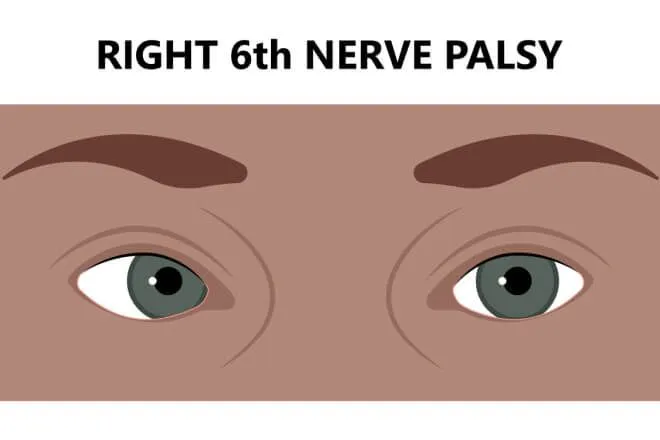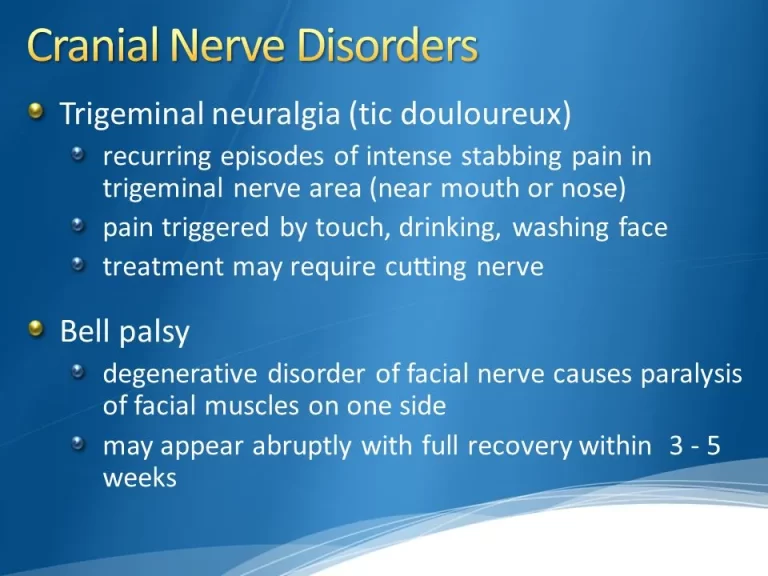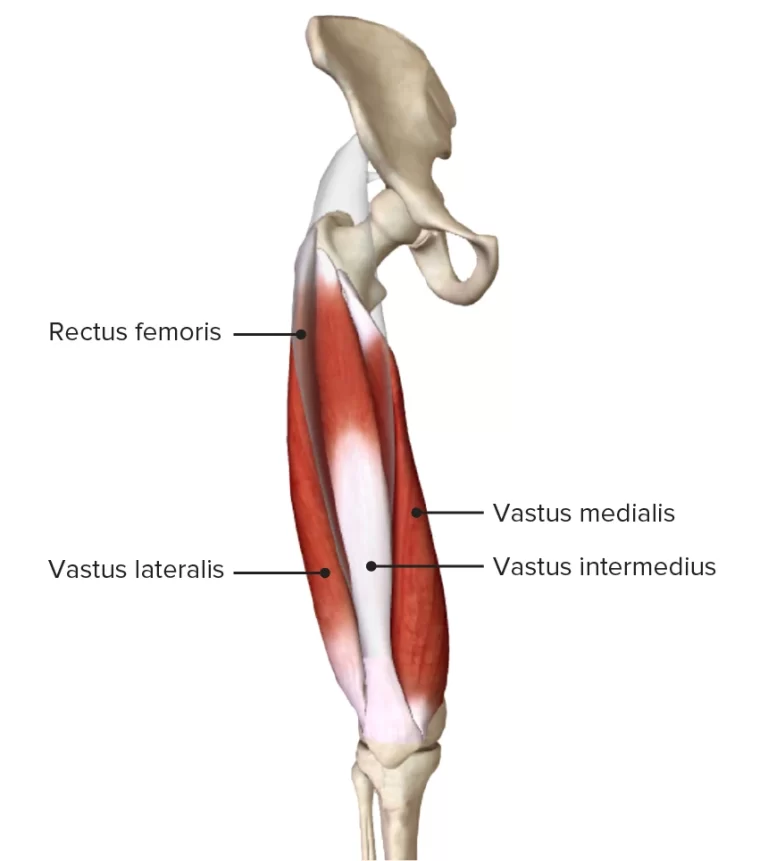Abducens Nerve Palsy
Abducens nerve palsy is a disorder where injury to a specific nerve disrupts eye movement and alignment. The abducens nerve, one of the pairs of cranial nerves, regulates the movement of your eyes away from your nose. Abducens nerve palsy is a nerve problem that involves eye muscle control.
It makes turning an affected eye outward difficult or impossible. It’s uncommon overall, although many potential causes are curable, and frequently no therapy is required. To avoid long-term consequences, early identification and treatment are essential.
What is the Abducens Nerve? Anatomy and its Function
The abducens nerve is one of the sixth pairs of cranial nerves. Its sole purpose is somatic motor function; it innervates the lateral rectus muscle.
Anatomical Course
- The abducens nucleus in the brainstem’s pons is the source of the abducens nerve. It leaves the brainstem at the point where the medulla and pons converge.
- Next, it passes through the dura mater and into the subarachnoid space, where it travels through Dorello’s canal.
- The abducens nerve exits Dorello’s canal and enters the cavernous sinus (a dural venous sinus) at the apex of the petrous temporal bone. It passes via the superior orbital fissure and the cavernous sinus before entering the bony orbit.
- The lateral rectus muscle is innervated by the abducens nerve, which finishes within the bone orbit.
Motor Function
- The abducens nerve innervates the lateral rectus muscle, an extraocular muscle.
- The lateral rectus connects to the anterolateral portion of the sclera after emerging from the lateral region of the common tendinous ring. It rotates the gaze away from the midline by acting to abduct the eyeball.
What is the Abducens Nerve Palsy?
- When a particular nerve is damaged, it might cause problems with eye movement and alignment, such as abducens nerve palsy. Usually unilateral it impacts just one eye, while it can occasionally affect both eyes simultaneously (bilateral). Another name for it is abducens nerve palsy (pronounced “ab-DEW-sens”).
- Damage or dysfunction of the sixth cranial nerve results in sixth nerve palsy. Another name for it is the abducens nerve. This illness makes it difficult for the eyes to move.
- The base of your brain is where the sixth nerve emerges. It goes a long way before arriving at the lateral rectus. A nerve can become damaged at any point, making it malfunction. The lateral rectus muscle can no longer contract regularly, causing your eye to tilt inward toward your nose.
- Sometimes abducens nerve palsy occurs without any additional symptoms. This condition is known as isolated abducens nerve palsy. abducens nerve palsy can occasionally present with additional symptoms. We refer to this as nonisolated abducens nerve palsy.
- Abducens nerve palsy can occasionally occur from birth. It may cause other issues. One of the main causes of youngsters is injury. Stroke is one of the most frequent causes in adults. It is rather rare.
How common is the Abducens Nerve Palsy?
- Rarely occurs abducens nerve palsy. Between 370,000 to 900,000 new cases are reported worldwide each year. Every year, between 15,000 and 37,000 new cases are reported in the United States.
- Abducens nerve palsy can affect anyone at any age, but the chances start to rise from 50 and continue to do so. Based on current studies, the age range when the risk of developing it is highest is between 60 and 75.
What are the causes of the Abducens Nerve Palsy?
The abducens nerve palsy can result from any illness or incident that injures your abducens nerve. Additionally, a part of it passes via the brain, so disorders affecting the brain can also impact the abducens nerve.
Abducens nerve palsy is frequently idiopathic, meaning it develops for no apparent reason. However, in most cases, there are identified and diagnosable causes. Among these are
- Injuries.
- Infections.
- Circulatory issues.
- Metabolic, inflammatory, and systemic disorders.
- Tumors, malignancies, and blood problems.
- Other neurological disorders.
- Medical procedures.
Injury
A head injury can harm the abducens nerve just like it can the brain tissue that surrounds it. Two such instances include traumatic brain injuries (TBIs) and concussions.
- Skull fractures.
- Penetration wounds to the head (such as those caused by bullets or sharp items).
Infections
An attack on your neurological system, particularly the abducens nerve, can be caused by bacteria, viruses, or other microbiological organisms. Among these are:
- Viruses such as the shingles-causing Herpes zoster virus.
- The virus known as the Epstein-Barr virus is the source of mononucleosis, or “mono.”
- Meningitis.
- CMV, or cytomegalovirus.
- Lyme illness.
- Syphilis.
- Parasitic or fungal infections.
- Otitis media, or infections of the ears, when they become serious or spread.
- Tissue infection and inflammation surrounding the eye is known as orbital cellulitis.
Circulatory issues
The abducens nerve may be impacted by abnormalities in the blood supply and circulation within your brain. An issue known as ischemia (pronounced “iss-KEY-me-uh”) arises when there is no blood flow. When cells don’t get adequate blood flow, that’s when problems occur. Severe ischemia or prolonged ischemia kills affected cells. The following circulatory disorders and incidents may result in sixth nerve palsy:
- Microvascular ischemia is the absence of blood flow through the tiny blood arteries supplying the abducens nerve.
- Transient ischemic attacks (TIAs) and strokes.
- Brain aneurysms.
- Intracranial hemorrhages or brain bleeds.
Metabolic, inflammatory, and systemic disorders
Multiple system conditions can also be the cause or a contributing factor in abducens nerve palsy. Examples include:
- Diabetes type 2
- Cardiovascular disorders.
- High blood pressure (hypertension).
- Wernicke-Korsakoff syndrome.
- Multiple sclerosis (MS).
- Lupus (systemic lupus erythematosus).
- Amyloidosis.
- Sarcoidosis.
- Thyroid diseases.
Malignancies, tumors, and blood disorders
Blood-related conditions can raise the pressure inside your skull, which can strain the abducens nerve by pressing on surrounding brain tissue. Additionally, the abducens nerve may be compressed by additional brain growth. A few examples are
- Leukemia.
- lymphoma.
- Brain tumors, both malignant and benign.
- Cancer with brain metastases.
Other neurological disorders
Abducens nerve palsy can result from or be worsened by a wide range of other neurological (nervous system-related) disorders. Examples contain:
- Migraines and cluster headaches.
- Intracranial hypertension results from an unknown etiology, often known as idiopathic hypertension.
- Hydrocephalus.
- Chiari malformation.
- Arteriovenous malformation (AVM).
- leaked cerebral spinal fluid (CSF).
Medical procedures
The abducens nerve may become injured or affected by specific medical procedures or treatments. Among the examples are:
- lumbar puncture, or spinal tap. If this results in a decrease in the pressure inside your skull, it might occasionally induce abducens nerve palsy. The surrounding cerebrospinal fluid (CSF) allows your brain to “float.” Your brain may droop and apply pressure to the tissue at the base of it, including the abducens nerve, when CSF levels fall.
- Epidural anesthesia. For the same reasons as a spinal tap does, this can result in abducens nerve palsy.
- Vaccinations. Rarely, some vaccines may cause you to experience milder versions of the illnesses they are meant to prevent. Fortunately, when this is the cause, sixth nerve palsy is moderate and transient.
- Radiation therapy or brain surgery. These may affect the nearest brain tissue, they may cause harm to the nerve.
What are the symptoms of the Abducens Nerve Palsy?
Abducens nerve palsy is characterized by movement or improper alignment of the eyes. While certain symptoms may only be associated with abducens nerve palsy, other symptoms may also be present in situations that either cause or aggravate abducens nerve palsy. Abducens nerve palsy’s main symptoms include:
- Misalignment of the eyes (strabismus). An outward misalignment that is noticeable to others may result from an impaired eye’s inability to turn properly. An affected eye may point inward due to misalignment (esotropia).
- Double vision, or diplopia. If you try to look at the affected side or at items that are farther away, this will get worse. assuming you glance at the unaffected side, it will get better (assuming you have it in only one eye).
- Changing position to improve visibility. When unable to turn one or both of their eyes in a specific direction, people with abducens nerve palsy may move their head or body. By doing so, they might be able to prevent double vision caused by misaligned eyes.
- Vomiting and Nausea. Double vision and visual irregularities can produce these. They may also occur as a result of illnesses that cause or worsen abducens nerve palsy.
- Pain. Headaches and eye strain can result from long-term visual problems or from straining your eyes excessively.
What are the risk factors of the Abducens Nerve Palsy?
There may be an increased chance of abducens nerve palsy in some individuals. While a cause such as those mentioned above may not always be the primary cause of abducens nerve palsy, it may facilitate the development of another cause. As an example, consider:
- Metabolic diseases such as diabetes type 2.
- Circulatory conditions, such as hypertension.
- Conditions that are inflammatory or autoimmune, like multiple sclerosis.
What is the diagnosis for the Abducens Nerve Palsy?
A mixture of techniques can be used by a medical professional, such as an ophthalmologist, neurologist, or neuro-ophthalmologist, to identify abducens nerve palsy. These consist of:
- Visual examination. To confirm that the abducens nerve is the only nerve impacted, a medical professional or eye care specialist will measure your ability to move your eyes in specific ways. This is due to the possibility that paralysis of other nearest nerves, particularly those that regulate eye movement, could coexist with abducens nerve palsy.
- laboratory examinations. These are essential for figuring out whether you have an infection, blood problem, metabolic condition, or any other condition that can be identified by lab testing. You will likely have your A1C or blood glucose tested. Other blood components like platelets, immune cells, or antibody levels pointing to an autoimmune disease may also be tested.
- MRI stands for magnetic resonance imaging. Abducens nerve palsy diagnosis requires an MRI scan, particularly in individuals under 50. The abducens nerve and the surrounding brain tissue are among the components within your head that can be seen in great detail on these tests. It can assist in determining the presence or absence of extremely dangerous or serious illnesses such as tumors, cancer, or strokes.
What is the treatment for Abducens Nerve Palsy?
Although abducens nerve palsy therapies range greatly, they often fall into one of two categories:
- Control whatever is causing the palsy.
- In cases when it is possible and appropriate, try to reverse the effects of the palsy.
It is mostly caused by one element, although there are other contributing causes as well. The abducens nerve palsy usually resolves on its own with treatments of the underlying disease. Your healthcare practitioner is the ideal person to ask about the best options for therapy because numerous factors might affect the best course of action for sixth nerve palsy. They can modify the content to meet your unique requirements and circumstances.
Many individuals require little or no treatment at all. If treatment is not immediately necessary, your eye doctor or healthcare provider will arrange for follow-up appointments to keep a check on your condition. Palsy treatment will only take place if it is deemed required. Treatment for the palsy’s effects is still probably going to happen, though. The effects of palsy are easier to treat; often, the symptoms are reduced or eliminated. The following are some therapies that lessen the symptoms of abducens nerve palsy:
- Wearing a filter or eye patch. By preventing input to one eye, covering one helps in the treatment of double vision. Depending on your situation, your doctor may advise wearing an eye patch sometimes or consistently. Wearable light-blocking filters which typically come in the form of attachments for glasses operate similarly.
- Injection of onabotulinum toxin A. A temporary blockage of impulses passing through treated nerves can be achieved with botulinum toxin A. It can be injected close to certain nerves to help with eye misalignment.
- Strabismus surgery. Abducens nerve palsy can be treated surgically in a few different ways. When the lateral rectus muscle is weaker, some assist in strengthening its control. Others function similarly to the lateral rectus muscle by reattaching a portion of a muscle from the opposite side of your eye, which uses a separate nerve for transmission.
- Prism modification. These can be tiny, layered add-ons that you wear on your glasses’ lenses, or the lenses themselves can be constructed with a prism included in the prescription. When light is bent at the right angle, the prism effect can help your eyes align and focus more easily.
Physical-Therapy for Abducens Nerve Palsy
An important part of the recovery procedure for the trochlear nerve is physical therapy. Physical therapists can help patients with trochlear muscle palsy improve their overall health and functional vision.
Physical therapy Treatment is important in preventing possible future recurrence because the focus of therapy is on clinical presentations, which are usually physical limitations. Treatments used in physical therapy include:
Exercises for Eye Muscles:
- Blinking Exercise: By practicing blinking, you can extend the time that your eyes stay alert and focused. It’s similar to resting your eyes. Ten seconds of blinking every twenty minutes can help reduce dry eye, digital eye strain, and abnormal blinking patterns.
- Eye move: Moving your eyes slowly three times up and down and three times left to right.
- Figure 8: The figure of eight is another visual exercise. See a big figure of eight, 9, or 10 feet in front of you. Take around thirty seconds to move your eye in the direction of this infinity loop, and then reverse it.
- Concentration exercise: Get your finger a few inches in front of you, focus on it, then move your attention to somewhere far away, and then bring it back to your finger.
- Pencil push-ups. The patient’s thumb is extended midway between their eyes as they grasp a pencil. The pencil is to be moved progressively in the direction of their nose until it can no longer be seen in a single image, and they are to strive to keep the pencil in that single image. The next step is to carefully relocate the pencil to the closest location where the patient can still see it in a single image. This activity is beneficial for patients with symptomatic convergence insufficiency.
- Gait Training: A common strategy for gait training is working with a physical therapist to develop a secure and effective workout program. A training program may contain exercises to improve strength, balance, and coordination.
Electro-therapy: Patients were constantly treated throughout the whole path of the injured nerve using transcutaneous electrical nerve stimulation (TENS). Two electrodes were positioned, one at the end of the corresponding nerve and the other right in front of the ear.
However, the placement was altered as needed by pain referral and effectiveness. To stimulate muscles that have been weakened by abundant nerve palsy, electrical stimulation therapy uses electrical currents.
What complications could Abducens Nerve Palsy?
- The underlying cause and methods of therapy for abducens nerve palsy have a significant impact on the condition’s consequences. Your healthcare provider is the ideal person to ask about potential or expected complications in your situation, as well as what you may do to prevent or reduce them, as they could range greatly.
- One major issue that healthcare professionals will work to prevent in kids is amblyopia or lazy eye. It occurs when a child’s brain begins to ignore information from the other eye in favor of depending more and more on one. The alignment of the unusable eye will “drift” and become worse.
- Side effects of surgery: Surgery for strabismus may occasionally overcorrect or undercorrect for sixth nerve palsy. Prism correction is typically useful in situations such as these, as it can correct an overcorrection or compensate for an under-correction.
What is the prognosis for Abducens Nerve Palsy?
Overall, the prognosis for abducens nerve palsy is favorable. Most people only experience it temporarily, and it usually goes away either on its own or once the underlying causes are treated.
However, more severe disorders can also produce abducens nerve palsy in certain circumstances. That is more likely to occur in people under 50 and/or in cases when both eyes are affected. In any case, seeking medical attention is usually a smart idea if you exhibit abducens nerve palsy symptoms. The difference between a full recovery and long-term (or even permanent) damage can be determined by early diagnosis and therapy.
What are the prevention for Abducens Nerve Palsy?
Abducens nerve palsy can occur at any time. It frequently occurs for unclear reasons and isn’t always caused by the disorders that can cause it. Thus, it cannot be avoided. But, there are some causes that you may control to lower your chance of having it. Examples contain:
- Using safety equipment as required. Abducens nerve palsy can result from head trauma, particularly from concussions and traumatic brain injuries. It is essential to wear safety gear to prevent this condition, especially helmets, head protection gear, seatbelts, and other safety equipment.
- Controlling your long-term health issues. Certain medical disorders, such as hypertension and Type 2 diabetes, are controllable. If needed, your healthcare provider can provide advice and treatment alternatives.
- Don’t neglect infections. If, after a few days, your infection-related symptoms don’t go better, see a doctor. Antibiotics are necessary for bacterial infections to stop the infection from growing or spreading. However, it’s crucial to keep in mind that viruses are treated with supportive care or on their own, and antibiotics cannot treat viruses.
Summary
Although abducens nerve palsy can cause major changes to one’s life, it is typically curable and temporary. On the other hand, receiving a diagnosis and treatment as quickly as possible is crucial. If you have difficulty moving your eyes outward, or in any direction, see a healthcare provider.
By doing so, the probability of a successful result will increase. In this manner, you won’t have your vision restricted by the consequences of this illness, and you can look forward to more significant things.
FAQs
What causes abducens nerve palsy the most frequently?
Ischemic mononeuropathy, which can result from diabetes mellitus, arteriosclerosis, hypertension, temporal arteritis, or anemia, is the most probable cause of isolated abducens nerve palsy in adults.
What signs and symptoms are present in abducens nerve palsy?
Patients who experience binocular horizontal diplopia double vision when looking at two things side by side are frequently diagnosed with abducens nerve palsy. This is because the ipsilateral lateral rectus muscle is noticeably weaker, making it impossible to abduct on the affected side.
How is abducens nerve palsy diagnosed?
Computed tomography (CT scan) or magnetic resonance imaging (MRI).
Spinal tap (lumbar puncture) to check for infection or bleeding.
Blood examinations to look for inflammation.
How is abducens nerve palsy treated?
Using a filter or eye patch. By preventing input to one eye, covering one aids in the treatment of double vision.
Injection of onabotulinum toxin A. A temporary blockage of impulses passing through treated nerves can be achieved with botulinum toxin A.
Surgery for strabismus.
Prism adjustment.
What other name is there for abducens nerve palsy?
In adults, abducens (sixth cranial) nerve palsy is the most prevalent cause of ocular movement paralysis; in children, it is the second most common. The lateral rectus muscle, which abducts the eye, is controlled by the abducens nerve. Due to the opposing medial rectus muscle’s unopposed activation, abducens nerve palsy results in esotropia.
Is it possible to cure abducens nerve palsy?
The cause of sixth nerve palsy determines how to treat it. Abducens nerve palsy symptoms frequently disappear or become better after a few months. If the symptoms don’t go away entirely, you may require additional medical care, including surgery.
Is abducens nerve palsy caused by diabetes?
A benign yet uncommon cause of cranial neuropathy is diabetes mellitus. Patients with diabetes may experience abnormalities in extraocular mobility involving the third, fourth, or sixth cranial nerve as a result of diabetic neuropathy. Simultaneous palsy of multiple extraocular nerves is uncommon.
What is the pseudo cranial nerve 6 palsy?
The sixth cranial nerve, the abducens, is crucial for lateral eye movement and dysfunction can result in a range of visual problems. A rare neurological disorder called pseudo-abducens palsy limits eye abduction even though the abducens nerve is still active.
References
- Higuera, V. (2023, April 13). Sixth nerve palsy. Healthline. https://www.healthline.com/health/sixth-nerve-palsy#outlook
- Professional, C. C. M. (n.d.-o). Sixth nerve palsy. Cleveland Clinic. https://my.clevelandclinic.org/health/diseases/sixth-nerve-palsy
- Articles. (n.d.-c). https://www.cedars-sinai.org/health-library/diseases-and-conditions/s/sixth-nerve-palsy.html
- Graham, C., Gurnani, B., & Mohseni, M. (2023, August 24). Abducens nerve palsy. StatPearls – NCBI Bookshelf. https://www.ncbi.nlm.nih.gov/books/NBK482177/
- Rubin, M. (2023a, November 4). Sixth cranial (Abducens) nerve palsy. MSD Manual Professional Edition. https://www.msdmanuals.com/en-in/professional/neurologic-disorders/neuro-ophthalmologic-and-cranial-nerve-disorders/sixth-cranial-abducens-nerve-palsy
- Sixth Nerve Palsy/Cranial Nerve VI Palsy – American Association for Pediatric Ophthalmology and Strabismus. (n.d.). Higher Logic, LLC. https://aapos.org/glossary/sixth-nerve-palsy
- TeachMeAnatomy. (2019, March 13). The Abducens Nerve (CN VI) – Course – Motor – TeachMeAnatomy. https://teachmeanatomy.info/head/cranial-nerves/abducens-nerve/







